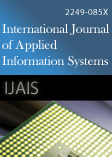
- Ajiboye Adeleke R. and Adewole Kayode S. and Jimoh Rasheed G. and Oladipo Idowu D. 2013. Modeling and Evaluation of E-Voting System for a Sustainable Credible Election. International Journal of Applied Information Systems. 5, 3 (February 2013), 8-14. DOI=http://dx.doi.org/10.5120/ijais450862
-
@article{10.5120/ijais2017451568, author = {Ajiboye Adeleke R. and Adewole Kayode S. and Jimoh Rasheed G. and Oladipo Idowu D.}, title = {Modeling and Evaluation of E-Voting System for a Sustainable Credible Election}, journal = {International Journal of Applied Information Systems}, issue_date = {February 2013}, volume = {5}, number = {}, month = {February}, year = {2013}, issn = {}, pages = {8-14}, numpages = {}, url = {/archives/volume5/number3/424-0862}, doi = { 10.5120/ijais12-450862}, publisher = { xA9 2012 by IJAIS Journal}, address = {} } -
%1 450862 %A Ajiboye Adeleke R. %A Adewole Kayode S. %A Jimoh Rasheed G. %A Oladipo Idowu D. %T Modeling and Evaluation of E-Voting System for a Sustainable Credible Election %J International Journal of Applied Information Systems %@ %V 5 %N %P 8-14 %D 2013 %I xA9 2012 by IJAIS Journal
Abstract
Voting is an action considered to be fundamental in a democratic setting. E-voting can be referred to as an election that involves using an electronic device for the purpose of casting votes. Lack of transparency and other problems associated with semi-manual method of casting vote in Nigeria has indeed called for a more robust electronic voting system. In this paper, a model for evaluating e-voting system using fuzzy logic approach is proposed. The model was simulated and tested for students' union election using a Federal University in Nigeria. Opinions of the students regarding the proposed model were randomly sampled and analyzed for the purpose of evaluation especially when compared with the existing system of voting. Furthermore, factors that can guarantee free and fair election were discussed and put into consideration during the development of the model. The result shows that the proposed model was effective, efficient and reliable for implementing electronic voting system.
References
- Hasanali, A. , Abbas, N. A. and Hossein, N. (2011). Environmental Performance Evaluation Based on Fuzzy Logic, International Conference on Social Science and Humanity IPEDR vol. 5. Singapore: IACSIT Press.
- Askerbeyli, I. N. and Abduljabar, J. S. (2011). Using fuzzy logic methods for carbon Dioxide control in carbonated beverages, International Journal of Electrical & Computer Scienc, IJECS-IJENS 11(3), pp. 196-202.
- Feras, A. H. , Mutaz, K. H. and Khairall, M. A. (2011). New applied e-voting system; Journal of Theoretical and Applied Information Technology, 25(2), ISSN: 1992-8645, pp. 88-97.
- Engels, G. , Forster, A. , Heckel, R. and Thone, S. (2008). Process Modeling using UML, Retrieved on 8th December, 2012 from: http://www. itu. dk/courses/SMD/F2008/TH/EFHT05PAIS. pdf.
- Mendel, J. M. (2001). Uncertain Rule-Based Fuzzy Logic Systems: Introduction and New Directions, Prentice-Hall Publishing Company. ISBN: 978-0130409690.
- Komminist, W. , Richard, A. K. , and Adolfo, V. (2011). Formal analysis of an electronic voting system: An experience report. Journal of Systems and Software.
- Nurmi, H. , Salomaa, A. , and Santean, L. (1991). Secret ballot elections in computer networks. Computers and Security, 36 (10), pp. 553-560.
- ORG, (2007). Electronic Voting. A challenge to democracy? Retrieved on 7th December, 2012 from http://www. openrightsgroup. org/uploads/org-evoting-briefing-pack-final. pdf
- Reza, B. (2005). Mobile Computing Principles: Designing and Developing Mobile Applications with UML and XML; New York: Cambridge University Press.
- Simon, B. , Steve, M. and Ray, F. (2007). Object-Oriented Systems Analysis and Design using UML (3rd ed. ); Mc Graw Hill.
- Susanne, C. (2010): E-voting handbook; Key steps in the implementation of e-enabled elections; Council of Europe, ISBN 978 92-871-6948-8.
- Tadayoshi, K. , Adam, S. , Aviel, D. R. and Dan, S. W. (2004). Analysis of an electronic voting system. IEEE Computer Society Press.
- Alvarez R. M , Hall, T. E and Trechsel, A. H. (2009): Internet Voting in Comparative Perspective: The Case of Estonia. JSOR 42(3), pp. 497-505, Retrieved on 28th January, 2013 from : http://www. jstor. org/stable/3542534.
- Moyniha, D. P. (2004): Building Secure Elections: E-Voting, Security, and Systems Theory. Public Administration Review, 64(5), pp. 515-52, Retrieved on 28th January, 2013 from : http://www. jstor. org/stable/3542534.
- Schneier, B. (2003). Beyond Fear: Thinking Sensibly about Security in an Uncertain World. New York: Copericus Books.
Keywords
E-voting, democracy, UML, fuzzy-logic, election
 10.5120/ijais12-450862
10.5120/ijais12-450862
